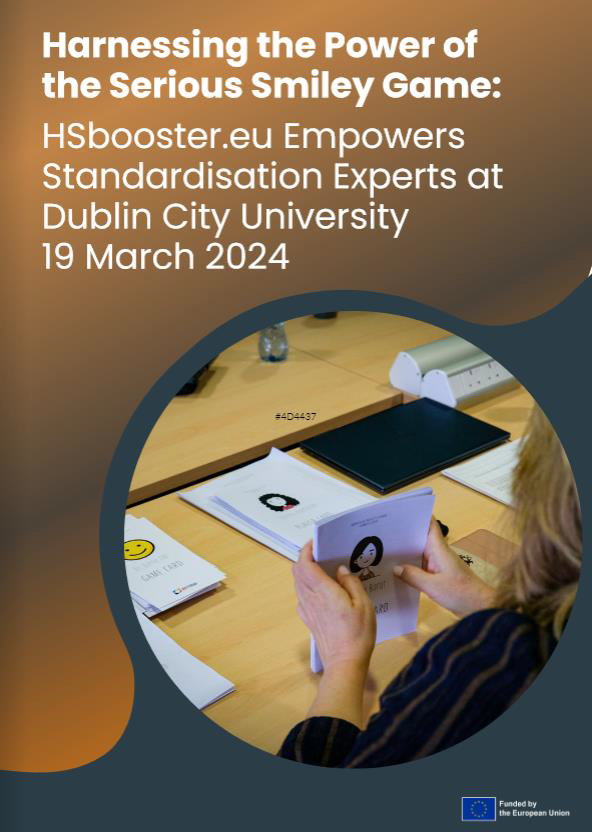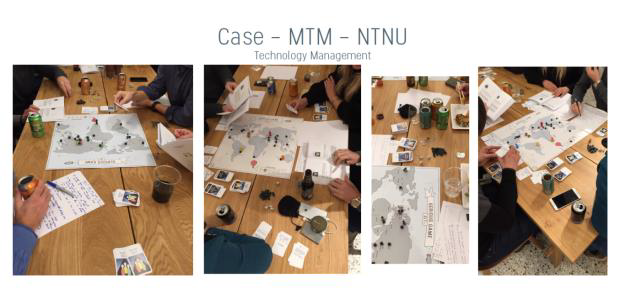Short instruction
Ideally, standards incorporate valuable and innovative ideas to represent the best technical solution to a problem. And the process of standardisation, in itself, can be a source of new innovative ideas as well. Hence, there are interesting interdependencies between standardisation and innovation. At the same time, some might have the feeling that standardisation and innovation are also opposites" (Perera, 2010), because the first appears to be about keeping things the same, whereas the second is about the development of new things. Firstly, there is the relationship between research and standardisation. While research at universities creates knowledge at the frontiers of knowledge and has the potential to create significant and independent contributions to standardisation (being a form of knowledge valorization), it is not easy to make this knowledge transfer channel work to its best extent (Bekkers et al., 2006) so stakeholders, such as the European Commission are investigating ways how the outcomes of publicly funded research and innovation (R&I) projects can be brought into standardisation (EC, 2023b). Economists are also conducting econometric work on ‘standard-relevant publications’, aiming to understand which scientific results are actually utilized in standards (Blind & Fenton, 2022). Secondly, there is a relationship between economic growth, trade, and standardisation. When standards perform roles, such as reducing variety, codifying knowledge, and offering compatibility, among other things, they create economic effects. such as economies of scale, network effects, and reduction of transaction costs, which affect trade as well as wealth and welfare (Swann, 2010a). Standards can remove trade barriers and promote open markets but can also act as inhibitors and limit access to national markets. The development, use and national adoption of standards can create strategic advantages on the global market: empirical studies suggest that the national level of adoption of both national and international standards has a positive effect on export, whereas the effects on import are mixed (Swann, 2010b). The uneven distribution of ownership of Standard Essential Patents (SEPs, see below) across the globe creates ‘have-not’ countries (Contreras, 2016). Standardisation can also contribute to economic growth as a whole (Blind et al., 2011), even though isolating the exact extent of that contribution is difficult. Finally, there is a relationship between intellectual property rights (IPRs) and standardisation. Especially anticipatory standards seek to include the most innovative ideas to meet challenging design requirements and expectations for the new standard, but those that create such innovative ideas often patent them. Over the years, SDOs have developed policies for patents in standards. IETF and W3C (the key standards bodies for internet standards) avoid the inclusion of patented technologies unless it is guaranteed that royalty-free licenses are available to any implementer. Many other standards bodies, such as ISO, IEC, CEN, CENELEC, and ETSI, adopted a policy where patent owners are allowed to request monetary licenses for patents that are required to implement the standards (Standard-Essential Patents – SEPs), but the owners must commit themselves that these licenses are available under Fair, Reasonable, and Non-Discriminatory (FRAND) conditions. Even with these frameworks in place, SEPs have remained an area in which disputes occur, and we see both court cases as well as policy interventions (Maskus et al., 2013). In 2023, the European Commission proposed the ‘Essentiality’ Regulation, which introduces, inter alia, a public system that provides transparency on which precise patents are essential to technical standards (Bekkers et al., 2022).
The ILOs examples
K6.1., K7.1., S6.6., S7.2., S7.3., S7.7., S7.8., S7.11.
Recommended Teaching Case studies/Serious games/Оther
1.Serious Game: The World of Standardisation (DIN)
Keywords: Standardisation & Innovations
About: The World of Standardisation (DIN) is interactive board game with objective to develop a strategic understanding about standardisation in innovation context. Storyline: Congrats, for you innovation you won the Innovation Trophy! It comes with some time and money. The game offers different choices: patent, standard national/ European/ international, specifications; and combinations are possible. Decisions to be made within the team. The game provides real-life-inspired standardisation situations, and it is designed to inspire questions.
Details:
- Time to play: according to decisions Ca. 30 min per round.
- Group size: played in teams of 2-5, max. 2 teams per board.
- Target group: students, founders
- Languages: English, German
- Contact: amelie.leipprand@din.de

2. Serious Smiley Game (UoB, HSbooster.eu)
Keywords: Standardisation & researchers
About: The Serious Smiley Game is a role-play and simulation game that aims to develop soft skills needed in standardisation processes, focusing on argumentation skills, common understanding and strategic positioning. Furthermore, it emphasizes the role of a researcher with innovative ideas in a standardisation context. It is a facilitated game based on careful instructions to provoke communication among the game participants and increase their understanding of the process of reaching a common understanding, which is the first and primary step for achieving a common agreement. The Serious Smiley Game is publicly available and can be played at professional training or university classes.
Details:
- Time to play: 60 to 90 minutes
- Group size: played in teams of 5, one facilitator can facilitate up to 6 teams (30 persons)
- Target group: students (simplified version), researchers, standardisation professionals
Languages: English, Serbian.
Background: The first version of this game was developed in 2015 by Professor Ivana Mijatovic. Since then, the game has been played regularly in the Standardisation course of bachelor studies at the Faculty of Organizational Sciences, University of Belgrade. For the HSBooster.eu Training Academy, this game has been improved and tested on different sites. The experiences are positive. We thank Magnus Hakvag, CEO of the House of Knowledge, who gave us valuable advice and suggestions and thus contributed to improving this game
Contact: ivana.mijatovic@fon.bg.ac.rs

3. Serious IP Game
Keywords: IP, IPR, SEP, Innovation
About: This game is a dilemma game where the players will have to choose different countermeasures on different incidents and related to agreed long-term goals related to the WIPO global innovation index. In the game, the teamwork on how to improve a country's innovation performance as measured by GII. In this particular edition, the players relate to SEP and how to improve Norway’s score.
Details:
- Time to play: This game can be completed in 1 to 5 hours, depending on the team/time.
- Group size: 3-5 players per group.
Target group: Organizations or teams broadly
Contact: magnus.hakvag@hoknowledge.com

4. Serious Game: SIT Edition
Keywords: IP, IPR, Standards, Innovation
About: In this game the players will have to relate to the most relevant inputs, facts and incidents about Innovation, Standards, IP and IPR and how this is part of a company’s different policies. During game play the teams have as a team, with inputs from facilitator produced solutions to the most common challenges any type of organization will meet in, innovation, IP and standards and jointly created policies.
Details:
- Time to play: This game can be completed in 2 to 4 hours, depending on the team/time.
- Target group: Organizations or teams broadly
Group size: 3-5 players per group.
Contact: magnus.hakvag@hoknowledge.com
Background: https://vimeo.com/172708694

5. Serious Game: War Room
Keywords: IP, IPR, Strategy
Standardisation is part of decision-making and activities but not the main focus.
About: This game links IP, IPR, business development, standards, innovation, and competitiveness with business strategy using our IP and Competitiveness Canvas. Players are presented with a case to analyze by assessing and evaluating available information. Game cards are used to present information, from which players extract relevant details, make decisions, and set up a strategy. The team is then exposed to several happenings they must relate to, to see if their strategy “holds water”, and consider what they could have done differently.
Details:
- Time to play: This game can be completed in 1,5 to 4 hours, depending on the team.
- Target group: Organizations or teams broadly
Group size: 3-5 players per group.
Contact: magnus.hakvag@hoknowledge.com
Background: https://vimeo.com/223297825

6. Serious Game: War Room Corporate
Keywords: IP, IPR, Strategy
Standardisation is part of decision-making and activities but not the main focus.
About: Similar game to War-room, where we follow the company from War-room when the company has become a big corporate dealing with standards, SEP and Transfer pricing. This game links IP, IPR, business development, standards, innovation, and competitiveness with business strategy using our IP and Competitiveness Canvas. Players are presented with a case to analyze by assessing and evaluating available information. Game cards are used to present information, from which players extract relevant details, make decisions, and set up a strategy. The team is then exposed to several happenings they must relate to, to see if their strategy “holds water”, and consider what they could have done differently.
Details:
- Time to play: This game can be completed in 2 to 4 hours, depending on the team.
- Target group: Organizations or teams broadly
- Group size: 3-5 players per group.
- Contact: magnus.hakvag@hoknowledge.com
7. Serious IP-Department Game (CEIPI)
Keywords: Management system, IP, IPR, Innovation
Standardisation part of decision-making and activities but not main focus.
About: The Serious IP-Department Game is created in cooperation with CEIPI, University of Strasbourg. The Serious IP-Department Game is designed to create an engaging, facilitated exchange of experience and knowledge. Play happens in groups of 3-5 where the centrepiece of the game is an IP-department canvas, which is used to structure and evaluate relevant information (presented on playing cards), reveal interrelations, and support discussion. The game was played digitally by the MIPLM class, but it can also be played on-site with a physical game.
Contact: magnus.hakvag@hoknowledge.com
Background: https://ipbusinessacademy.org/a-serious-ip-department-game-5th-module-miplm

Good practice
Educators may use the Serious Smiley Game to develop soft skills needed in the standardisation process, such as argumentation skills, common understanding, and strategic positioning.
Recommended sources
- Abdelkafi, N., Bekkers, R., Bolla, R., Rodriguez-Ascaso, A., & Wetterwald, M. (2021). Understanding ICT Standardisation: Principles and Practice. ETSI (Vol. 2). (especially, Chapter 5 on standardisation and innovation, Section 5.3 on standardisation and research, and Chapter 7 on standardisation and IPR).
- Bekkers, R. (2017). Where patents and standards come together. In: R. Hawkins (ed.) Handbook of Standards and Innovation. Edward Elgar Publishing. DOI: 10.4337/9781783470082.
- Hawkins (ed.) Handbook of Standards and Innovation. Edward Elgar Publishing. DOI: 10.4337/9781783470082.
Other sources relevant to the topic:
- Baron, J., Spulber, D.F. (2018). Technology Standards and Standard Setting Organizations: Introduction to the Searle Center Database. Journal of Economics and Management Strategy, 27(3), pp. 462–503
- Bekkers, R., & Updegrove, A. (2013). A study of IPR policies and practices of a representative group of Standards Setting Organizations worldwide. Updated version. Washington, DC: National Academies of Science. Available at http://www.nap.edu/catalog.php?record_id=18510
- Bekkers, R., Blind, K., Coenen, H., Iverson, E. Jacobs, K., Hossain, K. (2006). Case studies on the interface between research and standardisation, and case studies on patent pools as a coordination mechanism. Project co-funded by theEuropean Commission within the Sixth Framework Programme, STREP, Priority 8, Contract 503 594.
- Bekkers, R., Duysters, G. & Verspagen, B. (2002). Intellectual property rights, strategic technology agreements and market structure: The case of GSM. In: Research Policy 31(7) 141-1161. DOI: 10.1016/S0048-7333(01)00189-5.
- Bekkers, R., Henkel, J., Tur, E.M., Vorst, T. v.d., Driesse, M., Kang, B., Martinelli, A., Maas, W., Nijhof, B., Raiteri, E., Teubner, L. (2020). Pilot study for essentiality assessment of Standard Essential Patents, Thumm, N. editor(s), EUR 30111 EN, Publications Office of the European Union, Luxembourg, JRC119894, doi:10.2760/68906, ISBN 978-92-76-16666-5.
- Bekkers, R., Tur, Elena M., Henkel, Joachim, Vorst, Tommy van der, Driesse, Menno, Contreras, Jorge L. (2022). Overcoming inefficiencies in patent licensing: A method to assess patent essentiality for technical standards. Research Policy 51(10). DOI: 10.1016/j.respol.2022.104590.
- Blind, K., Baldan, F., Tardos, G., Kromer, L. et al., (2024). European standardisation panel survey – Final report, Baldan, F., Tardos, G. editor(s). Publications Office of the European Union, ISBN 978-92-68-12065-1, doi:10.2777/643814.
- Blind, K., Gauch, S. (2009): Research and standardisation in nanotechnology: Evidence from Germany. The Journal of Technology Transfer, 34(3), 320–342.
- Blind, K., Fenton, A. (2022). Standard-relevant publications: evidence, processes and influencing factors. Scientometrics (2022) 127:577–602. DOI: 10.1007/s11192-021-04210-8.
- Blind, K., Jungmittag, A., & Mangelsdorf, A. (2011). The Economic Benefits of Standardisation: An update of the study carried out by DIN in 2000. Berlin: DIN. https://www.din.de/resource/blob/89552/68849fab0eeeaafb56c5a3ffee9959c5/economic-benefits-of-standardisation-en-data.pdf.
- Blind, K., Kenney, M., Leiponen, A., Simcoe, T. (2023). Standards and innovation: A review and introduction to the special issue. Research Policy, Vol. 52(8), pp. 104830. DOI: 10.1016/j.respol.2023.104830.
- Blind, K. Thumm, N. (2004). Interrelation between patenting and standardisation strategies: Empirical evidence and policy implications. Research Policy, 33(10), pp. 1583–1598.
- Contreras, J.L., (2016). Patents, standards and Borders. Workshop on Mega-Regionalism: New Challenges for Trade and Innovation (MCTI) Honolulu, Hawaii, USA, January 20-21, 2016.
- Contreras, J.L., 2019. Technical standards, standards-setting organizations and intellectual property: A survey of the literature (with an emphasis on empirical approaches). In: Depoorter, B., Menell, P., Schwartz, D. (Eds.), Research Handbook on the Economics of Intellectual Property Law, Vol 2 – Analytical Methods. Edward Elgar, Cheltenham and Northampton, pp. 185–235. DOI: 10.4337/9781789903997.
- European Commission (2023). REGULATION OF THE EUROPEAN PARLIAMENT AND OF THE COUNCIL on Standard Essential Patents and Amending Regulation (EU)2017/1001 COM (2023) 232 final.
- ISO. (2022). Standards and innovation – What does the research say? https://www.iso.org/publication/PUB100466.html.
- Leiponen, A.E. (2008). Competing through cooperation: The organization of standard setting in wireless telecommunications. Management Science, 2008, 54(11), pp. 1904–1919. DOI: 10.1287/mnsc.1080.0912.
- Maskus, K., Bekkers, R., Block, M.S., Contreras, J., Gilbert, R. J., Goodman, D. J., Marasco, A., Simcoe, T., Smoot, O., Suttmeier, R., Updegrove, A. (2013). In Maskus, K., & Merrill, S. A. (Eds.). Patent challenges for standard-setting in the global economy: Lessons from the ICT industry. Committee on Intellectual Property Management in Standard-Setting Processes Board on Science, Technology, and Economic Policy, Policy and Global Affairs. National Research Council of the National Academies. Washington, D.C: The National Academies Press. DOI: 10.17226/18510; ISBN 978-0-309-29312-9.
- Perera, C. (2010). Standardisation and Innovation. In W. Hesser, A. J. Feilzer, & H. J. de Vries (Eds.), Standardisation in companies and markets (3rd ed., pp. 403–442). Hamburg, Rotterdam: Helmut-Schmidt- Universität; Erasmus University of Rotterdam.
- Rysman, M., Simcoe, T. (2008). Patents and the performance of voluntary standard-setting organizations. Management Science 54(11), pp. 1920–1934. DOI: 10.1287/mnsc.1080.0919.
- Swann, G. M. P. (2010a). International Standards and Trade: A Review of the Empirical Literature. OECD Trade Policy Working Papers, No. 97, OECD Publishing. DOI:10.1787/18166873.
- Swann, G. M. P. (2010b). The Economics of Standardisation: An Update. Report for the UK Department of Business, Innovation and Skills (BIS). https://assets.publishing.service.gov.uk/media/5a790abd40f0b679c0a0812d/10-1135-economics-of-standardisation-update.pdf.
- Blind, K. (2009). Standardisation: a catalyst for innovation. Inaugural lecture at Erasmus University Rotterdam, available from http://hdl.handle.net/1765/17558
- Blind, K., Gauch, S. (2009). Research and standardisation in nanotechnology: evidence from Germany. The Journal of Technology Transfer 34(3), 320-342
- Wiegmann, P.M. (2019). Managing Innovation and Standards: A Case in the European Heating Industry. Cham: Palgrave Macmillan. https://link.springer.com/book/10.1007/978-3-030-01532-9